Hood Ornaments of Classic Cars
By: Matthias Dressler (Hood Ornaments of Classic Cars)

Hood Ornaments of Classic Cars
An informative web resource with weekly publications about interesting aspects about early hood ornaments / car mascot of the various car manufacturers from the period up to 1939.

Hood ornaments – a definition
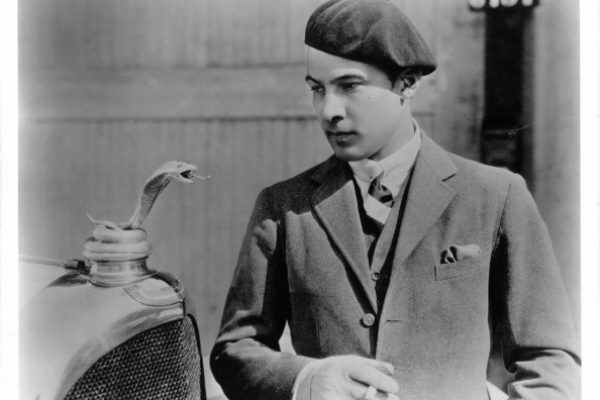
Rudolph Valentino, film icon of the silent film era, is looking at a snake radiator mascot on his car, 1925.
Hood ornaments, also called car/radiator mascots, are small sculptures that served as an ornament and distinctive feature of many car manufacturers, especially in the first half of the 20th century. They were usually mounted on the radiator grille at the front end of the hood of the vehicle.
Often they served as a good luck charm for the owner of the vehicle and were therefore called "mascots". Later these early "hood ornaments" developed into a kind of three-dimensional company logo and from then on often represented the brand values of the respective car manufacturer.
On this website, the terms "mascot" and "hood ornament" are used interchangeably, although the former should preferably be used for objects from before World War II.
Hood ornaments - the heirs of the figureheads
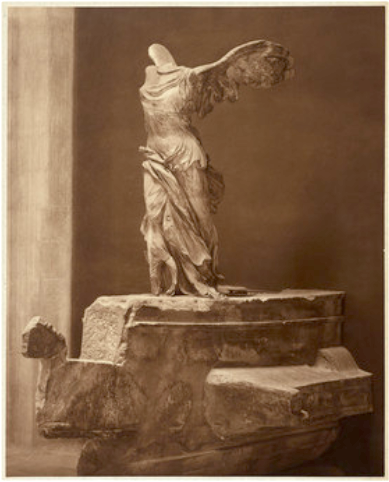
The sculpture of Nike of Samothrace, created around 200 BC.
The idea of decorating a vehicle with some kind of figure goes back much further. It is known, for example, that ships were decorated from earliest times to demonstrate power, whether against the living, threatening sea or other enemies, to gain protection from the gods, or to mark a geographical or topographical affiliation. The figurehead is what we think of first today: the pictorial element that makes up the face of the ship.
Victory over the sea, over enemies and rivals is clearly and iconically expressed in the sculpture of Nike of Samothrace (now in the Louvre), created around 200 BC. Here the female figure stands imposingly at the prow of the ship, giving it wings, as it were - a strong expression of mobility.
From this point of view, radiator figures are the heirs of the galleon figureheads. They must not only express a brand, but sell dreams and embody solidity, elegance, speed and mobility.
How hood ornaments came into being
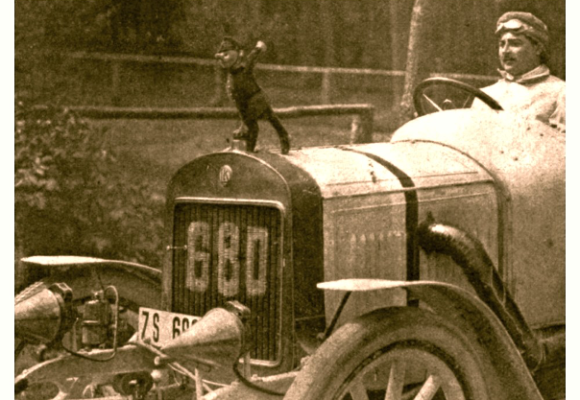
Personal radiator mascot on the hood of an early automobile, c1910.
You have to imagine that the first motorized vehicles, which had a little more power than, say, a single-cylinder motor carriage, were not entirely without danger. There were no real traffic rules yet and people were not yet used to higher speeds. So it didn't hurt to have a little good luck charm mounted on the vehicle. And so, until the 1910s, personal radiator mascots such as teddy bears, policemen and stuffed animals were relatively popular.
The evolution of the hood ornament
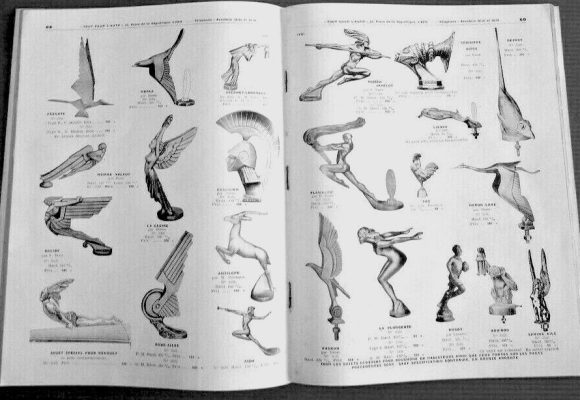
A French accessory catalog with radiator mascots, c1929
The first "real" car mascots mounted on the radiator cap appeared around 1910. They could be painted and were initially usually only available from accessory dealers. At that time, very few car manufacturers had their own brand-specific radiator mascot. During the 1920s, however, a kind of hype developed around the radiator mascot. By the 1930s at the latest, the radiator mascot was part of the standard equipment for almost every car brand.
Hood ornaments - facts and figures
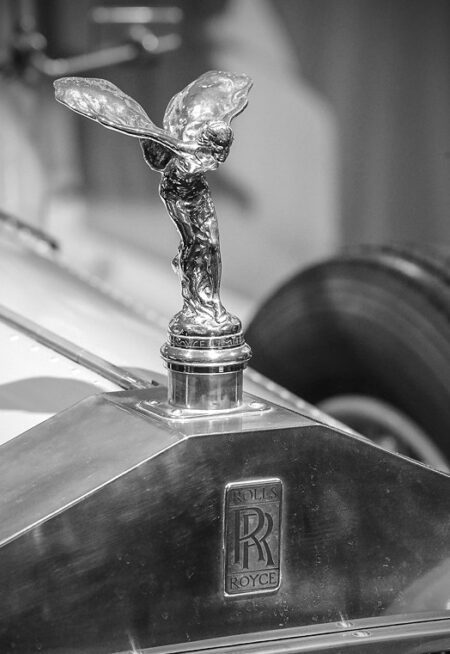
Rolls-Royce "The Spirit of Ecstasy" Radiator Mascot, 1911
One of the oldest and most famous radiator mascots is The Spirit of Ecstasy by Rolls-Royce. It dates back to 1911 and is still used today in a modified form.
The majority of car manufacturers in the USA and Europe used a radiator mascot. A particularly large number of radiator mascots were produced in America, which was due to the fact that there were over 2,500 car brands in the USA alone, and radiator mascots were even designed for individual model series. If you now include the accessory mascots, there could be 10,000 to 20,000 different radiator mascots.
In fact, there are a lot of different radiator mascots, which differ from each other on the basis of origin, material, design, age and purpose. At that time, a large number of various radiator mascots could be purchased as accessories in the aftermarket. These served to individualize the vehicle according to the taste of the vehicle owner.
Radiator mascots were also used in the commercial sector. For example, the delivery vehicles of certain companies had radiator mascots that often represented the company logo or product.Members of various organizations such as automobile clubs and other associations could indicate their affiliation via a radiator mascot. Especially in the royal sector, such as the British Royal Family, radiator mascots were and still are used for representative purposes.
The hood ornament as an objet d'art
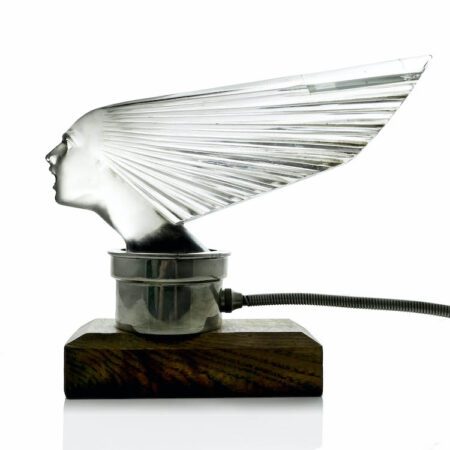
A rare 'Victoire' glass mascot by Rene Lalique, 1928
The pioneering period of the automobile coincided with Art Nouveau, which had its heyday at the beginning of the 20th century, and in the 1920s and 30s with the prevailing Art Deco, whose representatives were strongly aware of symbolism and allegory.
From the point of view of fine art, radiator mascots with their differentiated iconography represent an autonomous branch of small sculpture. Behind many famous radiator mascots stand equally famous sculptors who signed or stamped their works. In the case of bronze casts, seals of the corresponding foundry can sometimes be found. Rare are numberings that provide information about limited editions.
Radiator mascots made of glass, as created by the renowned artist Rene Lalique, were then as now worthy of special note. With a special fixture, which included a light bulb, these figures could be illuminated in the dark. It probably does not need to be pointed out that these small works of art were particularly susceptible to stone chips, and thus well-preserved pieces are particularly rare and correspondingly sought after.
Collecting hood ornaments
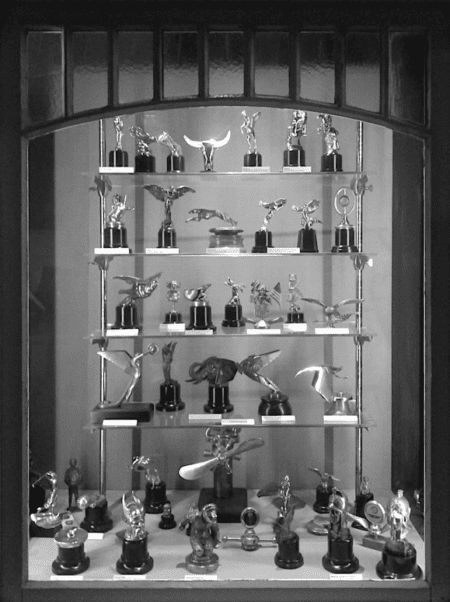
A collection of radiator mascots in the Louwman Museum, Netherlands
In fact, radiator mascots are now considered a collecting field within the somewhat more general area of Automobilia - collectibles of various kinds from the field of motorized mobility. First collections were formed in the 1960s, with probably many objects still found in junkyards or flea markets. In the 1980s and 1990s, a large number of objects were already traded through English auction houses. Since the 2000s, the Internet, especially ebay, plays a major role. Since the 2010s, sporadically larger collection liquidations come on the market, which are sold via art auctions.
Prices for radiator mascots depend on authenticity, rarity value and condition of preservation. The price range is from $10 to $250,000, with the majority in the triple digits. As with other art objects, the actual value is an ideal value, in that one is preserving a piece of cultural history. The material value is negligible.
It is particularly important to pay attention to reproductions.
More information about hood ornaments
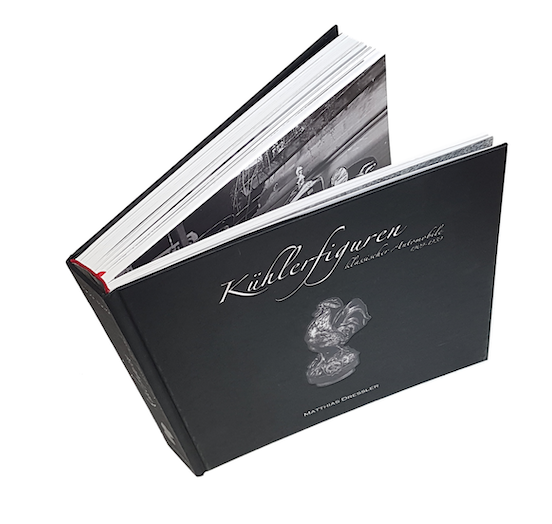
'Radiator Mascots of the Classic Car Era 1909-1939' by Matthias Dressler
The first reference book "Motoring Mascots of the World" dates from the 1970s and was quickly out of print. Thus, even into the late 1990s, it was very difficult to get information. There was simply hardly any literature on the subject. It was only with the advent of the Internet from the year 2000 that it gradually became possible to research effectively. Because every day old historical photos are uploaded or objects are offered for sale. In addition, there are now more books on the subject, such as Radiator Mascots of the Classic Car Era - a Book by Matthias Dressler, which should provide a very good overview.
Other possibilities to inform yourself will be this constantly growing web resource with the MarqueBLOG showing the mascots of every car maker worldwide.
To see radiator mascots in person, there are car museums like for example the Gilmore Car Museum (USA), AACA Museum (USA), Nethercutt Collection (USA), Louwman Museum (Netherlands), Musee National de l'Automobile (France) or Key Museum (Turkey).
No politics, no religion, no instagrams, and commentary must be civil. The ToS and the CoC will be enforced, and anything that the administrator deems to be offensive will be deleted. YouTubes, videos and images that the administrator is unable to open must be described and explained or they will be deleted.


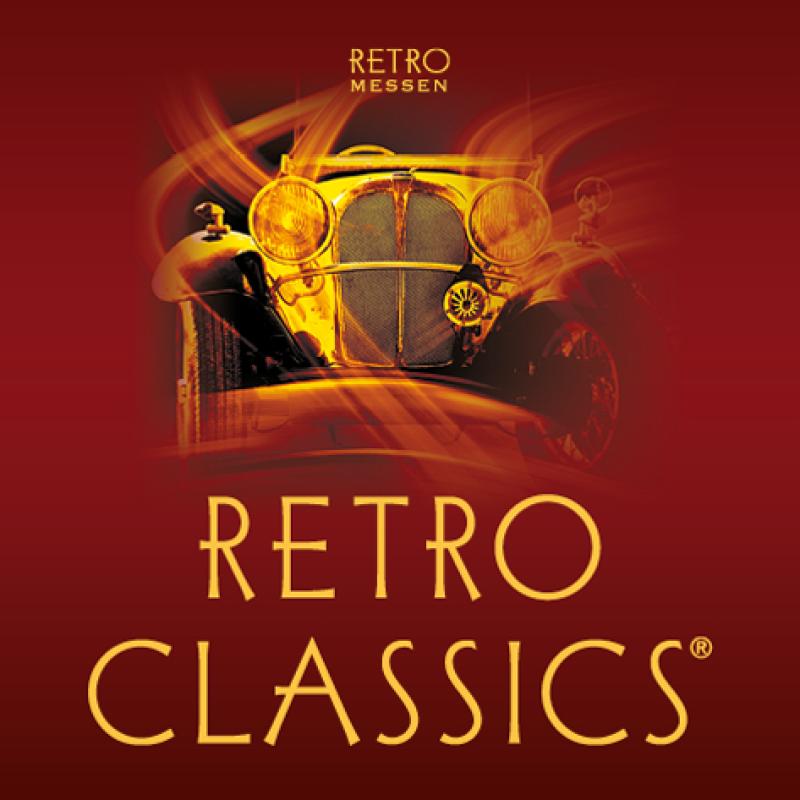
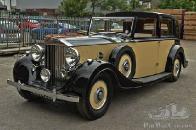
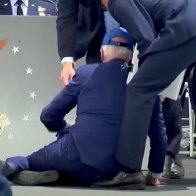








Hood ornaments have always been something I've taken note of when I look at any car. I don't think they are as prominent or interesting on cars now as they once were.
My Mom has a collection of hood ornaments...
It's such an unusual thing to be collected I'm surprised, pleasantly so, to know that.
Her collection is of glass hood ornaments, mostly by Lalique...
Lalique glass is unique and magnificent, as those glass ornaments show. I've considered Lalique to be a treasure for many many years.
Glad you enjoyed them. Here are a few more examples...
a fine collection
She collected over a long time. Some of the vintage ones can be really valuable. Because they were glass few survivors are available. I used to desire them, but am getting so old now that it is looking like my Mom will probably outlive me...
An amazing collection.
Do you have kids? Maybe they'll inherit them.
may both of you and the collection last a long time
You should see how people look at me when I talk of Mom. I am oldest and she is well preserved. We went on a vacation together and the hotel surprised us with the honeymoon suite. "We just thought you were the cutest old couple"...
Honeymoon suite!!! You made me laugh out loud.
We do have the same last name, but they got it all wrong. We thanked them, but opted for a room with two queen beds, instead of the giant round bed on a rotating pedestal...
Very interesting article!
I look for articles from which I can learn something new, and post them so members can learn about something other than politics.
I learn a lot and enjoy from your articles
Thank you.
Yes there are actually a few people on this site that want to learn new things (other than politics).
This is a bit off topic, and I realize that mentions of Astrology freaks out some people-- but that's an Aquarian trait (Aquarians often like to do things that contribute something to a group-- thats helps the group of people "improve" in some way).
Water signs (especially Pisces and Cancer) also like to help people but they focus on doing a lot to help one person-- Aquarians are more likely to think of bringing out the highest in a group--or even the world).
And people who have Trumpian Astrology can be very selfish...yep, its "selfishness all the way down"!
And since I just happen to be an Aquarian....
The Mack Truck Bulldog is a classic hood ornament
Cadillacs just do not have that special Cadillac thang anymore now without their distinctive hood ornaments...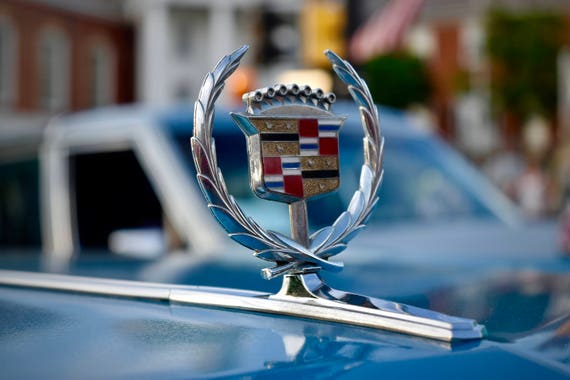
My father drove Cadillacs, but I never took much notice of their hood ornaments.
I remember that one--- it was long ago. And possibly there was another version like that? (Both had that similar thing in the center-- sort of like a "coat of arms" IIRC).
At the time, I always thought of Cadillacs as the ultimate luxury car (which of course was false, there were a lot of much more expensive cars in the world).
For some reason unbeknownst to me, my father always drove Oldsmobiles--- I don't think he ever owned a different brand car.
My father test drove a Jaguar Mark IX, I loved that car, but he passed on it and bought a Coupe de Ville instead. Broke my heart.
I think this was the original Mac hood ornament
It could scare the shit out of a Kenworth.
Nice, somewhere I have a Bulldog hood ornament
The Mack truck bulldog indicates power and strength.
During my sleep last night I remembered something relevant about this article. On my recent article about the sale of the "Black Ghost" Dodge Challenger I told the story about my borrowing and driving a vintage Rolls Royce limousine. Besides having to show me how to double clutch (which I had never done before) the Rolls Royce owner told me to remove and lock the hood ornament in the car when I was away from it. Obviously the hood ornament was not only considered valuable, hard to replace but a collector's item.